Arapahoe Project Receives Approval by West Hartford Town Council in Near-Unanimous Vote

Audio By Carbonatix
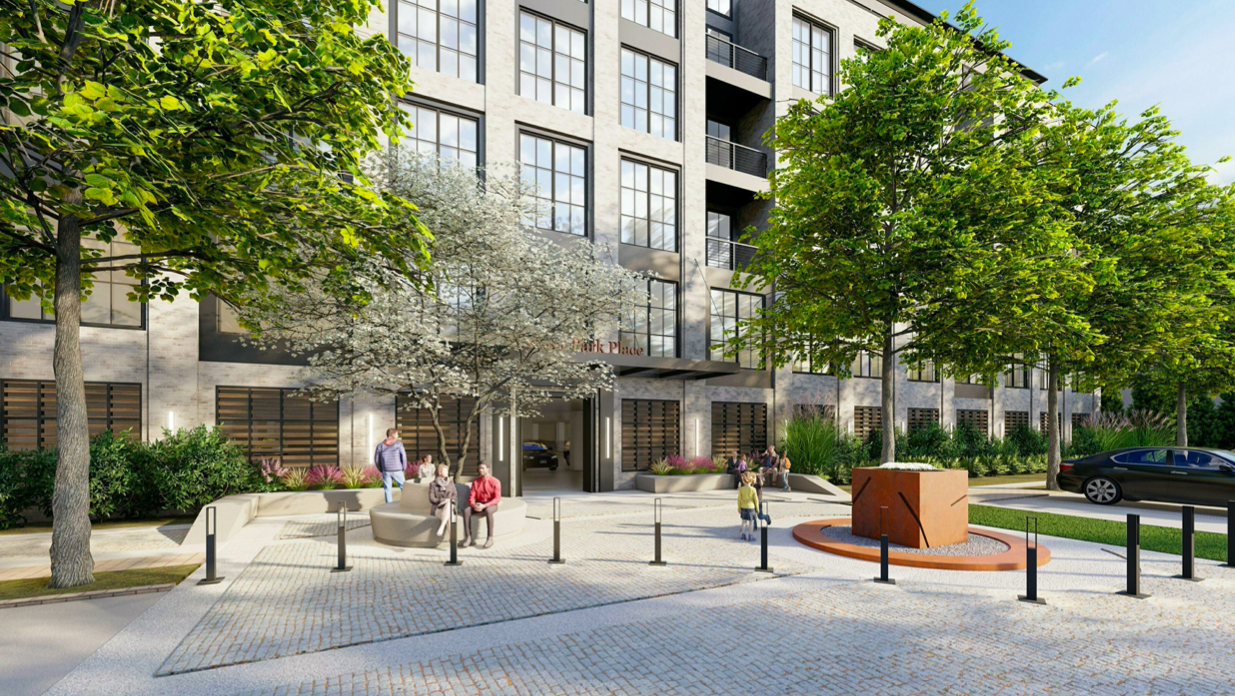
Rendering of Center Park Place by Beinfield Architecture. Courtesy image
Arapahoe Group LLC’s application for a Special Development District in West Hartford Center for a two-building project that will include condominiums, apartments, commercial occupancies, covered parking, a pocket park, and new pedestrian walkways was approved 8-1 by the Town Council Wednesday night.
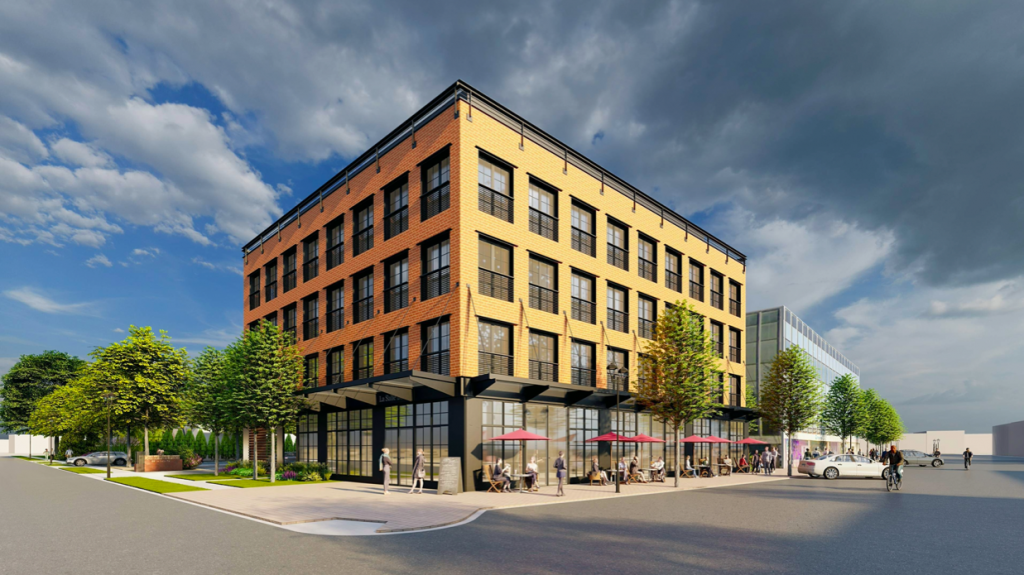
Rendering of 75 LaSalle by Beinfield Architecture. Courtesy image
By Ronni Newton
An application for a project that was the subject of a six-hour public hearing last week, and which inspired hundreds of emails to be sent Town Council members both in support and opposition, received overwhelming support in an 8-1 vote Wednesday night.
A proposal by the Arapahoe Group LLC to change the zoning of several properties in West Hartford Center to commercial, to combine them into a designated special development district (SDD), and to construct two new buildings, with a total of 83 residential units that will include high-end condominiums, rentals units, and workforce housing, along with commercial space and garage parking was approved, with all Council members expressing their appreciation for the input, as well as the concerns raised by the community, several of which were addressed in conditions that were part of the approval.
Mayor Shari Cantor thanked the applicant for the investment, her colleagues and town staff for their time considering this project. “But I really, really want to thank the residents for their commitment to the community,” she said. “All of your perspectives make us better. It challenges us to take action and make sure we are listening and we are accountable.”
Cantor said the community input has been extremely important.
“We heard about the traffic, we know that is a problem,” she said, and will be addressed through the West Hartford Center Master Plan that is currently under development, and will be coordinated with the traffic calming measures which Arapahoe Group will partner with the town in implementing.
“I do believe that this development will not add to the problems of traffic,” Cantor noted. “It will not add cars as much as it will add people,” she said, who are investing in the walkability of the area. Area retailers need that kind of foot traffic to survive.
“We do have to reinvent ourselves,” Cantor said. “I think what West Hartford has done is never sat back and say we’re good where we are.” The town is not only one of the top communities in the state but also is a top community in the country, “and if we stay still we won’t remain there, I am convinced of that,” she said.
“Blue Back led to further investment and we know and we feel this investment will also lead to further investment in our Center and our town. Times and conditions change so rapidly that we must keep our aim on the future and that is what we think this project does,” Cantor said.
This project has been years in development, dating back to at least 2016 when a proposal for increased density in the central business district (Zone BC) was submitted but was rejected. In 2017 the Town Council approved an “incentive zoning” ordinance, which allows for some level of increased density in exchange for infill development and certain amenities such as public parks and architecturally-screened and at least partially below-grade garage parking. This is the first application to fall under that ordinance.
“We extend our thanks to the Town Council members for the vision they demonstrated by approving this project,” Arapahoe group said in a statement following the vote. “The town’s collaboration during this process has made the project even better. We’re excited to augment the vibrancy of West Hartford Center, provide more residential options, and make a significant contribution to the town’s grand list.”
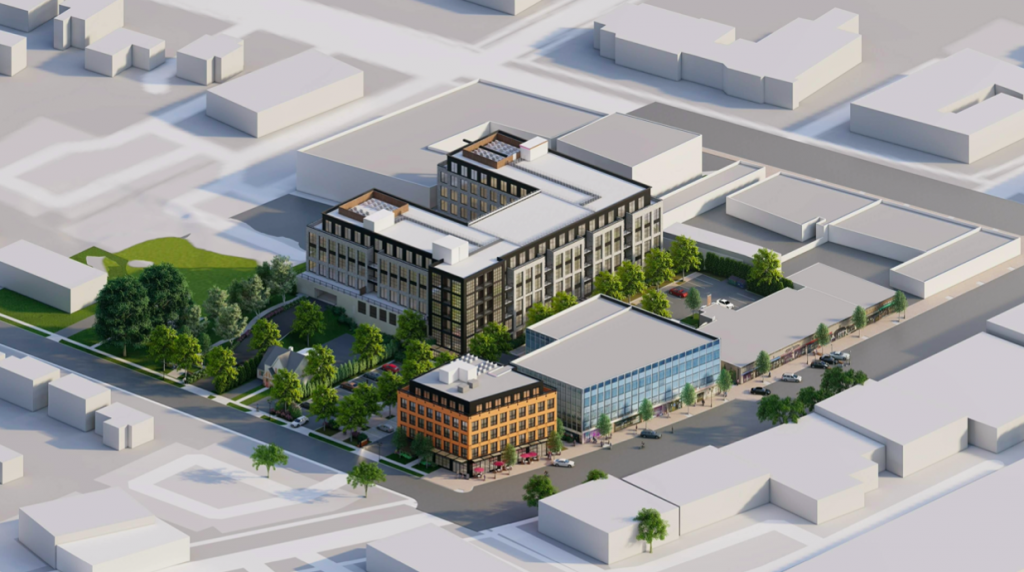
Rendering of the aerial view of proposed Arapahoe Group LLC development. Bohler Engineering / Beinfield Architecture (Town of West Hartford website)
Specific conditions of approval
Most notably, as part of the conditions of approval, the applicant – a partnership between Marc Lewis of Lexham – who is already the owner, through various entities, of all of the properties that would comprise the SDD, with the exception of 12 Arapahoe which is under contract to purchase, Jim Manafort of Manafort Construction, and Harris and Bruce Simons – is required, prior to receiving any building permits, to submit a lump-sum payment of $150,000 to the town to be used for traffic-calming improvements on Arapahoe Road and Woodrow Street.
The applicant offered during last week’s hearing, after hearing the concerns of area residents, to address traffic concerns and it was made a condition of approval. “We felt it was best to provide the town with maximum flexibility,” Corporation Counsel Dallas Dodge said regarding that condition, which requires that the town manager, town engineer, and other staff be responsible for approving and implementing the traffic calming, which must be completed within two years of issuance of the first building permit. Dodge said the town will not issue a certificate of occupancy until the traffic calming measures have been substantially completed.
Also required as a condition of approval are various requirements related to construction, including that contractors park personal vehicles off-site and that construction-related vehicles utilize designated routes established by the director of Community Development.
The project will be built in phases, and the town will also require that a building permit be obtained for the mixed-use 75 LaSalle Road building before granting a certificate of occupancy for the Center Park Place condominium building.
The applicant is also required to submit documentation of an agreement for at least 20 years for 40 offsite parking spaces at the Town Center Garage at 29 South Main Street.
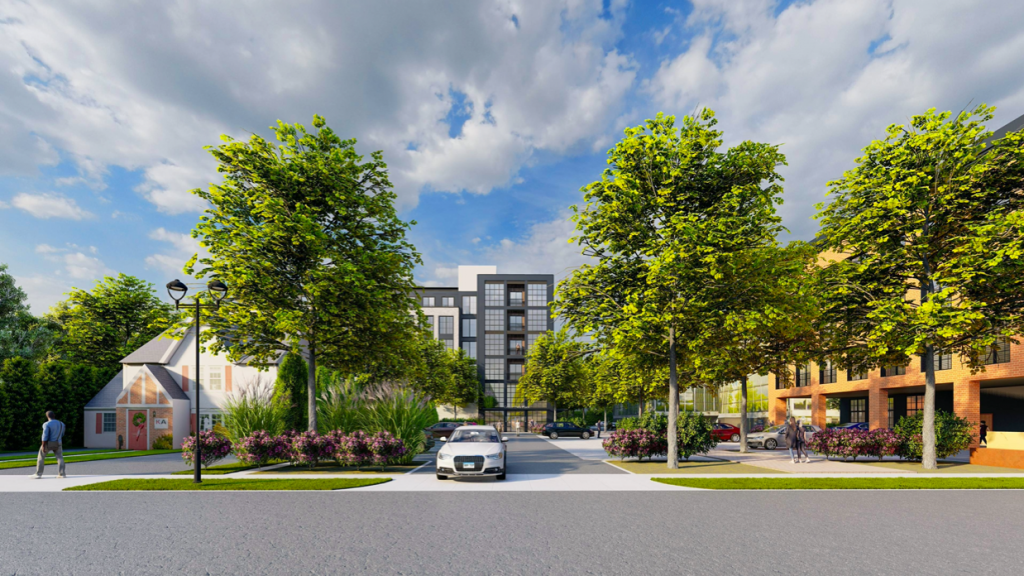
Rendering by Beinfield Architecture. Courtesy image
Protest Petition
Before the vote, which at 8-1 was well above the threshold of supermajority, Dodge reviewed the status of a protest petition, presented during the Dec. 13 hearing by Arapahoe Road resident Anna Boelitz, which was the reason for delaying the vote on the application until Wednesday night’s special meeting.
Chapter 7, Section 5F of the town charter requires supermajority approval by the Town Council on a zoning decision if a protest petition is presented at a public hearing – if that petition is deemed a legitimate protest based on its wording, and if the petition has been signed by the owners of 20% or more of the lots that are located within 500 feet of all directions of the parcel being considered. The 20% requirement is based on the square footage of the properties within that distance, not the percentage of property owners who sign, Dodge said, and he also noted that for a property to be counted the signatures of all owners of that property must be on the petition.
The Corporation Counsel’s Office, Town Planner Todd Dumais, and Town Clerk Essie Labrot were involved in the review process, and it was determined that only 18.4% of the lot area was represented by those who had signed the protest petition, Dodge said. Because that percentage did not meet the town charter’s requirement, the process of verifying the signatures or ensuring that actual (not electronic) signatures had been obtained from all owners did not need to take place.
Dodge noted that the petition was signed by more than 284 people, many of whom live both inside and outside the 500-foot buffer zone. In addition to its legal purpose, the petition did serve the political purpose of registering opposition, he noted.
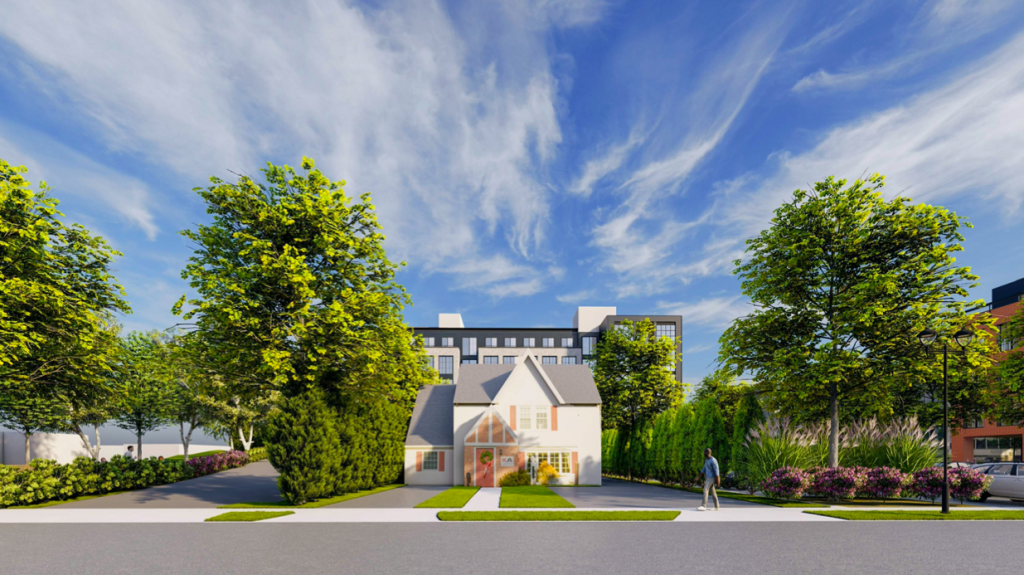
Rendering by Beinfield Architecture. Courtesy image
Council members voice support
Each Council member had the opportunity to share their thoughts before voting, and while Minority Leader Mary Fay ultimately cast the lone dissenting vote, she did offer praise as well.
“There’s so many things I love about this project. I love the design. … I love the condo concept,” Fay said. She said she wasn’t sure how she was going to vote and had reservations because of the protest petition, because of the need for the parking for 75 LaSalle to be off-site, and because of the size of the Center Park Place building, which she knows can’t be reduced due to economics. “The pros are there and the cons are there,” Fay said.
“Passion for the community is certainly appreciated and it underscores the commitment we all have for our town,” Democratic Councilor Carol Blanks said, noting how many members of the public had shared their opinions about this project and were part of what was truly a collaborative approach.
“This in my opinion is an opportunity to grow the grand list,” Blanks said. It’s an opportunity to develop underutilized space and 75 LaSalle will be a turnkey development that will appeal to young people, who are “the future of our town,” while the condos will be also be an option for those who are looking to downsize or for an alternative type of housing and want access to the Center, to transportation, to be able to make good use of the “ankle express.”
“I really believe the window of opportunity is now,” Blanks said. “I’m excited because it’s the future of our town.”
Democrat Ben Wenograd also expressed his respect for the residents who spoke to both sides of the issue, and in doing so showed their love for the town.
He said he supports adding housing to the Center and people’s lifestyle choices. “We created incentives for greater density,” with the addition of amenities, and while he expresses the concerns raised by the Design Review Advisory Commission (DRAC, which voted 4-1 not to recommend the project) with respect to scale, this project provides infill, public spaces, and more, and does meet the incentive zoning ordinance’s floor area ratio (FAR) requirements.
“I agree that transition is desirable, but see the condos as meeting that test,” he said in response to one of DRAC’s concerns, but it’s residential condominiums replacing a parking lot. In addition, Wenograd noted that the traffic problems of Arapahoe and Woodrow are recent, largely created by the town’s changes to LaSalle Road and other area roads.
“I have mixed feelings with this,” said Republican Alberto Cortes, who ultimately voted in favor of the project. He said he greatly appreciates the ownership aspect of the condominiums, the improvement of the alleyway between Union Kitchen and Webster Bank which is currently “a little sketchy,” and that at least some affordable housing was included. He said he was struggling with the size of the Center Park Place building.
Democrat Deb Polun said she appreciates “just how beautiful the buildings are going to be, the safety of the alleyways, the thought that went into redesigning” based on town input, and the addition of housing to this part of town.
“The traffic – this is a problem we have to solve together,” she said. “Some people came through with some great innovative ideas” for traffic-calming, and while she is not convinced that this project will exacerbate traffic, she is looking forward to seeing those implemented.
“We really need to have that input,” Republican Mark Zydanowicz said of the feedback from the public, and the detailed presentation from the applicant. It shows that people care.
“I think this is a natural progression for West Hartford. We need to grow our brand,” he said, and that brand needs to be grown for the future. He said one of the speakers at the public hearing said something which really resonated with him: “If you don’t like change you’ll hate extinction.”
As the town has evolved, Westfarms was predicted to be the death of the Center, but that didn’t happen, and then Westfarms opposed Blue Back Square. The development at 243 Steele Road brought 400 speakers in opposition to public hearings that stretched to three nights, but that project fits the area perfectly and has not created any problems.
“We don’t have anything like this now and I think it’s an opportunity for us to go forward,” he said, noting in particular the ownership aspect of the Center Park Place condominium building. While there is an existing issue with traffic in the area that needs to be solved, “I’m going to support this. I think it’s going to be great.”
Deputy Mayor Liam Sweeney said the input of residents and the applicant was very important.
The Town Council, with the use of American Rescue Plan Act (ARPA) funds, has been looking toward investment in the future. “What I think this development does is exactly that,” he said.
“West Hartford Center is our shining star,” Sweeney said, with developers knocking on the door. Great athletes don’t practice until they get things right, they practice until they can’t get it wrong, he said, and there has been lots of practice in getting to the submission approved Wednesday night, with many changes that have made it not perfect, but an excellent use of an underutilized space.
“Obviously there are significant concerns about traffic in town,” Sweeney said, which is a public safety matter, but this applicant wiling to put their money where their mouth is.
This project “will let us continue to shine,” he said.
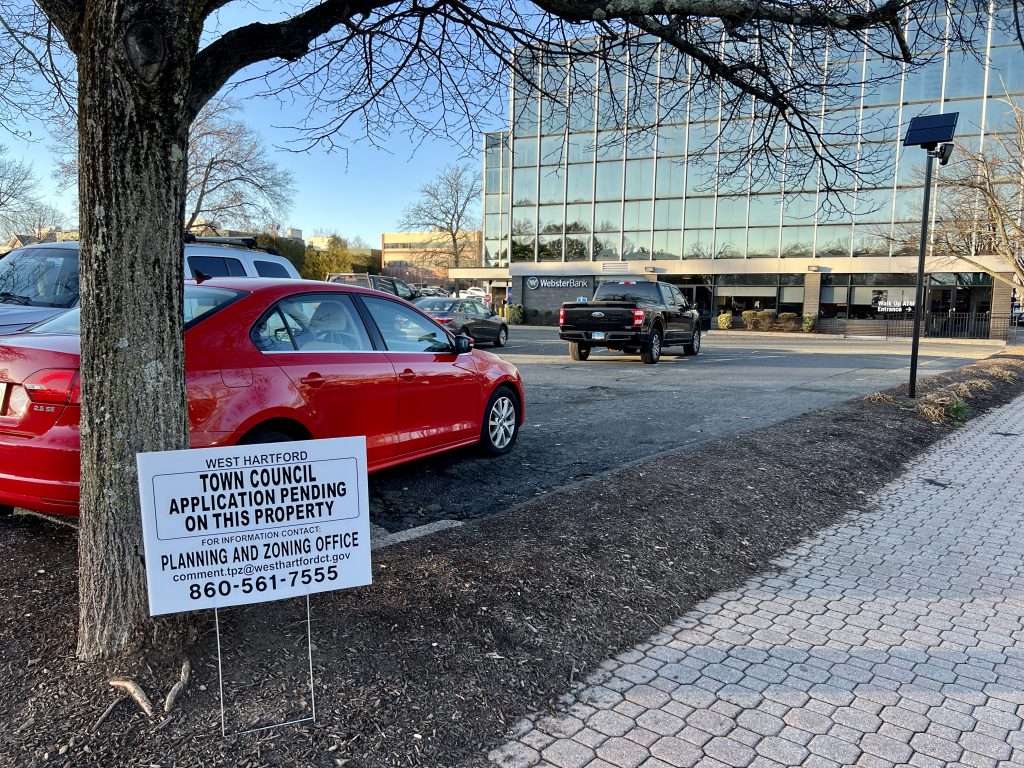
A five-story building –four levels of apartments and ground floor commercial space – will be built at the corner of Arapahoe and LaSalle roads. Photo credit: Ronni Newton (we-ha.com file photo)
Democrat Leon Davidoff, who before joining the Town Council 16 years ago was a member and chair of the Town Plan & Zoning Commission (TPZ), was extremely thorough in noting how and why this checked off all of the boxes in compliance with the town’s standards and processes.
“A lot of the neighborhood opposition deals with quality of life in their neighborhood,” Davidoff said. They were respectful, voiced sincere objections, and there are issues, particularly with traffic, that will be addressed.
While he said residents are respectful, “they need to be a little bit more respectful when going through people’s neighborhoods,” Davidoff said, noting one of the speakers last week said a driver had been clocked at more than 60 mph, which is completely unacceptable.
Davidoff said this is one of the first times he’s seen a non-positive referral from DRAC, and while that is concerning, he noted that their role is advisory and is limited to design standards. “They don’t govern land use,” he said, and one of DRAC’s stated concerns was the location of the Center Park Place building on the site. “I think that they may have overstepped their boundary in review of the application, that’s not really within their jurisdiction.”
The incentive zoning ordinance passed in 2017 was intended to facilitate “ways for the town center to experience incremental growth,” Davidoff said, to increase the vitality of the Center and still make it the destination that we want it to be. Then the pandemic had a profound impact on the Center with restaurants struggling with the uncertainly of people ever returning to indoor dining, retailers deemed non-essential being forced to close for 90 days. There has also be transformation of spaces that were formerly unique boutiques into storefront offices.
“What can the town do to promote economic vitality? … and we’re at that juncture where there needs to be more feet on the street. There needs to be more customer base,” Davidoff said. That will come with residents, and these residents will live right in the BC zone.
Davidoff said he likes to find ways to resolve differences, and is confident of the applicant’s commitment to work with the neighborhood to find solutions to keep traffic off Woodrow and Arapahoe.
“I find that outreach is a very important element during the process of any application,” Davidoff said, and while he believes, and Cantor also stated in her remarks, that there should have been a more robust engagement process, the neighborhood was definitely made aware of the application.
For future projects, applicants “need to engage with the neighbors. You need to listen to them. You need to give them respect. And you need to demonstrate good faith in the things that you promise.”
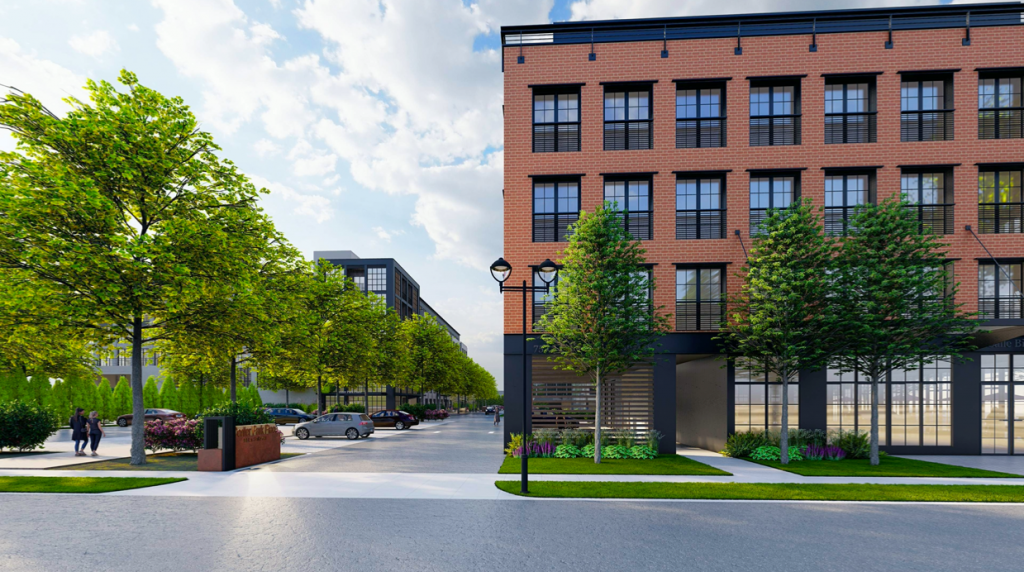
Rendering by Beinfield Architecture. Courtesy image
Like what you see here? Click here to subscribe to We-Ha’s newsletter so you’ll always be in the know about what’s happening in West Hartford! Click the blue button below to become a supporter of We-Ha.com and our efforts to continue producing quality journalism.




I appreciate the council not listening to the noisy minority and thinking outside the box
And kudos too for ignoring the first adverse recommendation by the town’s own DRAC.